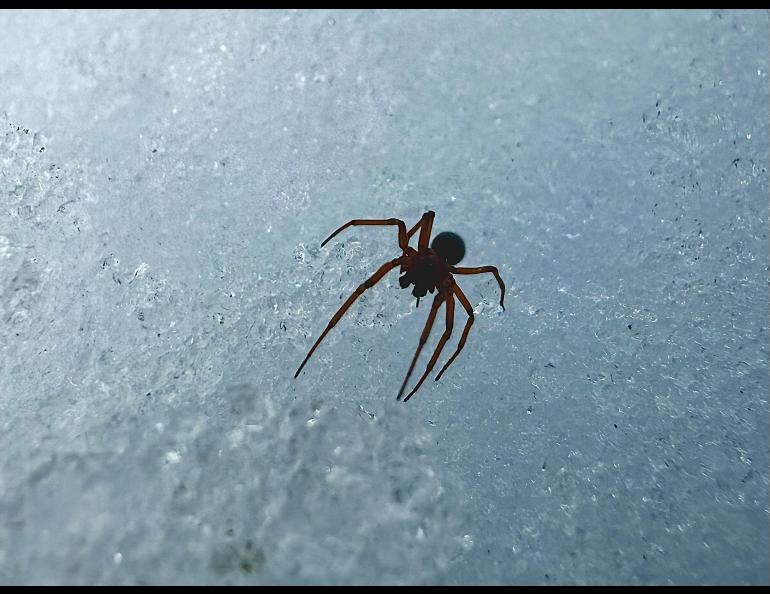
Creepy Critters in the Snow
While skiing on the cushion of snow that recently covered Fairbanks, I saw a spider on top of the snowpack. Snow seems a poor choice for the stroll of a cold-blooded creature, so I called Steve MacLean, an expert on small, creepy things.
“My guess is that the spider came down from the trees, where it might have been hanging out waiting for spring,” said MacLean, a professor emeritus with UAF’s Institute of Arctic Biology. “But if they’re going to overwinter up there, they have to have some cold protection.”
As Alaska enters winter, countless millions of insects are wedged into crevasses in trees and mixed with leaves on the forest floor. These insects use different strategies to survive the long wait until spring. MacLean said the spider on the snow was using either freeze tolerance or supercooling to survive.
Freeze tolerance is just as it sounds—insects turn into little bits of ice, then thaw in spring to fly or crawl away. To pull off this trick, insects or their larvae must remove much of the water from within their cells and keep ice organized to remain outside cell membranes. They also add sugars and alcohols to their bodies to counter the effects of freeze-drying. If ice forms inside cells or if cells become too dry, the insects die. Insects aren’t the only organisms to use this strategy to survive; trees and wood frogs survive after being mostly frozen much of the year.
Supercooling is a trick used by many insects to wait out the deep cold. Yellowjackets and stinkbugs are among the many insects that get rid of any impurities in their bodies that might trigger the formation of ice when their body liquids are below 32 degrees Fahrenheit. By purging anything in their guts and sometimes ridding their bodies of bacteria, insects can withstand temperatures well below freezing. Keith Miller, a former UAF biologist, found that larvae of the gall wasps, which spend winter in fuzzy little balls on the surface of willow leaves, can avoiding freezing down to minus 60 by adding glycerol to their body fluids.
Yellowjackets and stinkbugs are supercoolers, but they aren’t as hardy as gall wasp larvae. Like many insects, yellowjackets and stinkbugs choose to spend winter beneath the snow. With a good snow cover, the temperature at ground level can remain just below freezing for much of the winter, no matter how cold the air above the snow pack. In experiments he and his students performed, UAF professor Brian Barnes found that yellowjackets and stinkbugs can cool to about 7 degrees F (-12 degrees C) before they freeze and die.
If wintering under the snowpack keeps an insect warmer, why do some, like the spider on the ski trail, choose to spend the cold months above the snow? MacLean said the warmth under the snowpack might prevent an insect from becoming dormant, forcing it to use resources it needs to make it to spring. A climb out into the cold air might trigger the shutdown an insect needs to survive. A chilly winter home in trees or stumps might also help an insect avoid predators beneath the snow, such as shrews that feed all winter. Another possible reason to tough it out above the snowpack is to get a jump on other insects in spring. Insects not under an insulating blanket will be the first to feel the warm air, and the first to shake off the effects of a long winter.





